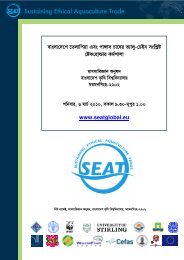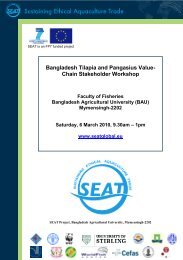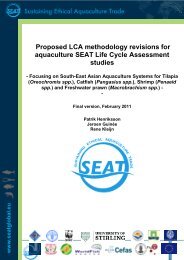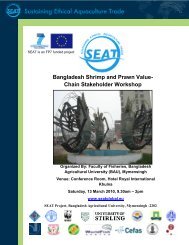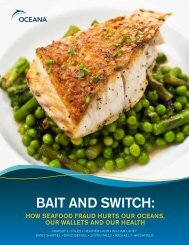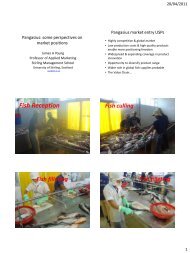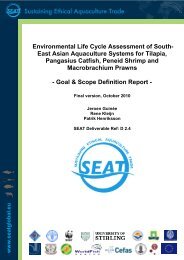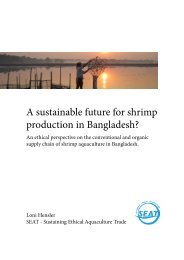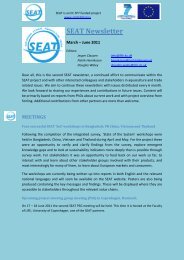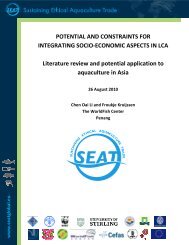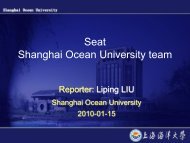D4.1 Review of Environmental Models - SEAT Global
D4.1 Review of Environmental Models - SEAT Global
D4.1 Review of Environmental Models - SEAT Global
Create successful ePaper yourself
Turn your PDF publications into a flip-book with our unique Google optimized e-Paper software.
1.3.4 IAAS (Integrated Aquaculture/Agriculture System)<br />
Aquaculture systems in SE Asia <strong>of</strong>ten integrate aquaculture and agriculture, resulting in a<br />
shared movement <strong>of</strong> material between the 2 systems (Pullin et al, 1993). Although<br />
integration <strong>of</strong> these systems is well known, there are few models, which have been<br />
developed specifically for this purpose.<br />
The IAAS (Integrated Aquaculture/Agriculture System) model is a relatively new model<br />
developed by Jamu and Piedrahita (2002a). Its purpose is to simulate the movement <strong>of</strong><br />
organic matter between the two systems. The model simulates fish and crop production,<br />
organic matter, phytoplankton, dissolved oxygen and the nitrogen dynamics in the system<br />
(Jamu & Piedrahita, 2002a). The IAAS model is made <strong>of</strong> 2 modules - Aquaculture and<br />
Agriculture - which are then divided into four sub modules. The Aquaculture module is split<br />
into fish pond water column and fish pond sediment, whereas the Agriculture module is<br />
separated into terrestrial soil and terrestrial crop. Within these sub-modules there are 19<br />
state variables each with a separate mass balance simulations (Jamu & Piedrahita, 2002a).<br />
Model simulations use time steps <strong>of</strong> 0.125 days, enabling simulation <strong>of</strong> multiple production<br />
cycles and potentially over longer periods <strong>of</strong> time (Jamu & Piedrahita, 2002b).<br />
The model was developed through the s<strong>of</strong>tware package STELLA TM (Jamu & Piedrahita,<br />
2002b) and calibrated using data from the PD/A CRSP for a site in Rwanda cultivating tilapia<br />
in a fertilised pond (Jamu & Piedrahita, 2002a). Having undergone validation it was found<br />
that the model performed well for the fish and crop biomass production, organic matter and<br />
nitrogen. It did however demonstrate errors when simulating phytoplankton production,<br />
probably through not considering zooplankton grazing. If this was added the model would<br />
be considerably more robust (Jamu & Piedrahita, 2002b).<br />
1.3.5 AWATS (Aquaculture Waste Transport Simulator)<br />
This is a waste transport model developed using a series <strong>of</strong> existing validated models. The<br />
overall model simulates the transport <strong>of</strong> wastes from finfish net pen aquaculture systems<br />
and is intended to be used for regulatory purposes (Dudley et al, 2000). The model package<br />
includes the finite difference model, DUCHESS, integrated with the s<strong>of</strong>tware SMS (Surfacewater<br />
Modelling Systems) to provide a user friendly interface with a graphical output. The<br />
package also includes the transport model TRANS which simulates the advection and resuspension<br />
<strong>of</strong> particulate wastes (Dudley et al, 2000). The final component <strong>of</strong> the AWATS<br />
package is the Automated Coastal Engineering System (ACES) to model wave velocity which<br />
effects waste settling rates.<br />
The AWATS modelling package has been tested in the USA in 3 different Bays (Machias Bay,<br />
Blue Hill Bay and Cutler Harbor). The results from the simulations proved to be “relatively”<br />
robust, showing its strength for environmental regulatory purposes although more data are<br />
required to calibrate the model (Dudley et al, 2000).<br />
1.3.6 MMFA (Mathematical Material Flow Analysis)<br />
The MMFA model was originally developed for economic modelling in the 1930s (Hall & Day<br />
Jr, 1977). In recent years the model has been developed for use in pollution monitoring and<br />
Page 16



